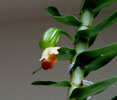|
|
|
|
|
| |
Flasks of
Dendrobium ellipsophyllum 'Memory Lane' × 'MC390' |
|
| |
|
|
| |
| Number: |
TN1221 |
| Name: |
Dendrobium ellipsophyllum 'Memory Lane' × 'MC390'
(Acquired incorrectly named as Dendrobium revolutum)
|
| Type: |
outcross (What's that?) |
|
Seed Donor: |
Marla Nikirk
(Email: mknikirk@gmail.com)
|
|
Click to Enlarge

Pod Parent Flower |
Click to Enlarge

Pod Parent Developing Capsule |
Click to Enlarge

Pod Parent Blooming Plant |
Click to Enlarge

Offspring 'MC4434' Flower |
Click to Enlarge
![Thumbnail]()
Offspring 'MC4434' Flowers |
| Offspring photos are siblings of the plants you would receive. |
|
|
|
| |
Culture Notes from Donor: Pod parent plant: Temperature range I (60-83°F)
Comments: The flowers of the pollen parent look almost identical to the pod parent, except the color is muted and the keels are quite pale.
Pod parent plant: Blooms all year, repeatedly on the same cane. Nice fragrance, reminiscent of lilacs.
For additional origin/habitat information supplied courtesy of
Charles and Margaret Baker, see further below, near the bottom of this page.
|
Temperatures we attempt to use in the lab & greenhouse:
| For Species: |
|
Spring, Summer, Autumn, Winter: days average 84°F, nights 68°F; best fit is Warm-Intermediate 87-64°F
(Source:
Baker's Web OSC) |
| For Species: |
|
Winter: days average 81°F, nights 49°F; best fit is Cool-Intermediate 75-58°F
(Source:
Baker's Web OSC) |
|
About the name...
| Etymology of |
Dendrobium |
|
From Greek "dendron" tree and "bios" life.
(Source:
Pridgeon 1992) |
| Etymology of |
ellipsophyllum |
|
From latinized Greek "ellipsophyllus" with oval leaves.
(Source:
Mayr & Schmucker 1998) |
| Pronunciation of |
Dendrobium |
|
den-DRO-bee-um
(Source:
Pridgeon 1992) |
|
If you would like to direct someone to this web page, please copy and paste this URL into your email:
http://troymeyers.com/d?011221
| Flask Information |
| Availability: |
We have sold all of the flasks for this item. |
| You should: |
Consider getting individual plants or compots instead of a flask.
You can place a "Notify Flask Recipients" Request, and either we or a flask recipient may contact you when plants are available.
You may also place a "Notify Retries" Request, and if an identical pollination (the same parents) is done again, we'll let you know.
You may reserve a flask, but it's very unlikely you'll get one ...this could only happen if we found a flask that we didn't know we had. |
| Yield Estimate: |
330 plants (based on flask surveys done 03/28/2002 through 10/08/2002)
|
| Plantlet Sizes: |
From many flasks 10 - 50 mm plants (based on flask surveys done 03/28/2002 through 04/01/2003)
From one most recently surveyed flask 25 - 40 mm (04/01/2003)
|
|
You might also want to:
|
View the seed assay for this item.
View items of the same species.
View items of the same genus.
|
| Ordering Information |
| You are not currently logged in. |
|
You must be a registered user and be logged in to reserve a flask or place a notification request. Please log in:
|
|
|
|
|
|
| |
The origin/habitat information below is supplied courtesy of Charles and Margaret Baker
The following information is based on the name of the plant provided by the donor, and assumes that the name is correct. If the plant has been misidentified, then the following information may not be correct.
This text is copyrighted by the Bakers and may not be reproduced without permission.
ORIGIN/HABITAT: Widespread throughout much of Southeast Asia. Plants grow
near Moulmein, Burma, across much of Thailand, Cambodia, Laos, the region
near Dalat, Vietnam, and Yunnan Province in southwest China. In Thailand,
plants are found at 1000-3300 ft. (300-1000 m).
More about this information and the Bakers...
|
|
|
| |
|
|
|